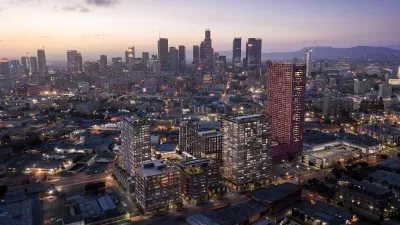The arts district in downtown Los Angeles is transforming its industrial buildings into trendy boutiques, restaurants and hotels. The concern is that gentrification will drive out low-paid artists who can no longer afford to live there.
"It was far more exciting for me to be in a place that wasn't already 'there,' so to speak," said Yassmin Sarmadi, who began building her restaurant Church & State seven years ago. She not only works, but also lives, in the arts district. Of gentrification, she said, "I think it's inevitable. It brings a tear to my eye, but it's also progress." Scott Johnson, an architect who also lives in the art district, appreciates the neighborhood's "roughness most suburbanites would find off-putting" in a time when "we're getting bombarded with fake stuff." Los Angeles's arts district has drawn comparisons to New York's meatpacking district and will likely face the same fate of gentrification from its industrial past, "[b]ut for now, the arts district is in a sweet spot of transition for many," writes Roger Vincent.
"When the arts district loft conversion trend took off in the mid-2000s, landlords realized they could get more rent from tech and design companies than they could from warehouse and manufacturing businesses," says Vincent. He adds, "With so many prosperous newcomers making the neighborhood into an urban frontier with hip amenities, some residents are laboring to keep art in the arts district." Commercial rents in the arts district can top $2 per square foot per month, more than prices paid for nearby high-rises.
"It's already too pricey for the majority of artists," said Daniel Lahoda, owner of Lala Gallery. "We will endure the increases as long as we can because we love the neighborhood so much."
FULL STORY: Downtown L.A.'s edgy arts district is neighborhood in transition

Study: Maui’s Plan to Convert Vacation Rentals to Long-Term Housing Could Cause Nearly $1 Billion Economic Loss
The plan would reduce visitor accommodation by 25,% resulting in 1,900 jobs lost.

Placekeeping: Setting a New Precedent for City Planners
How a preservation-based approach to redevelopment and urban design can prevent displacement and honor legacy communities.

Using Old Oil and Gas Wells for Green Energy Storage
Penn State researchers have found that repurposing abandoned oil and gas wells for geothermal-assisted compressed-air energy storage can boost efficiency, reduce environmental risks, and support clean energy and job transitions.

Washington State Plans Ambitious ‘Cycle Highway’ Network
The state is directing funding to close gaps in its existing bike network and make long-distance trips more accessible.

Homeowners Blame PG&E for Delays in ADU Permits
The utility says it has dramatically reduced its backlog, but applicants say they still face months-long delays for approvals for new electrical work.

Rethinking Wildfire Defense: How a Landscape Approach Can Protect Neighborhoods
Post-fire analysis of the Eaton Fire reveals that a landscape approach — including fire-resistant vegetation, home hardening, and strategic planning — can help reduce wildfire risk, challenging assumptions that trees and plants are primary fire hazards.
Urban Design for Planners 1: Software Tools
This six-course series explores essential urban design concepts using open source software and equips planners with the tools they need to participate fully in the urban design process.
Planning for Universal Design
Learn the tools for implementing Universal Design in planning regulations.
Borough of Carlisle
Caltrans
Heyer Gruel & Associates PA
Institute for Housing and Urban Development Studies (IHS)
City of Grandview
Harvard GSD Executive Education
Salt Lake City
NYU Wagner Graduate School of Public Service
City of Cambridge, Maryland




























